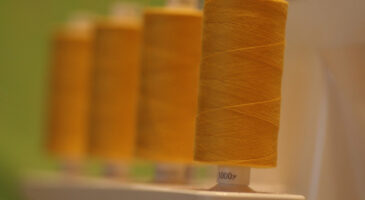Before the advent of quilting or modern-day bedding fabrics, people from the ancient period wrapped their straw-filled beds with a basic sack known as a tick.
This method was adopted to make sleeping on the traditional straw-filled bed more comfortable, and the herringbone pattern of the fabric also prevent insect, feather, and straw from punching through when in use.

In more recent times, this fabric has transcended beyond ordinarily using it as bed covers. This fabric is now commonly used for curtains and upholstery due to its complementary color and the negative gaps that give the fabric its unique pattern.
Unfortunately, this fabric is not much talked about, so people commonly ask, what is ticking stripe fabric? You will learn about this question in this article.
What are ticking stripe fabrics?
Ticking stripe is a tightly woven 100% cotton material made traditionally as a cover for thick mattresses and bed pillows.
This fabric is usually made up of 3 lines (2 fine lines with a thick line in the middle). Ordinarily, ticking stripe is tightly woven, but they are further starched, soaped, and waxed in an offer to make them tighter and more durable.
What is ticking stripe fabric made from?
Ticking stripe fabric can be either made from 100% cotton or a blend of linen and cotton.
When was ticking stripe fabric invented?
The production of ticking stripe fabrics started over a thousand years ago. However, the use of the fabric for upholstery purposes started in 1940 when Sister Parish, a renowned American decorator, brought the fabric into a refined sitting room setting in New York.
Since then, the stripe has become popular for sofa upholstery, duvet covers, drapery, tote bag, and bed skirts.
What can I make with a ticking stripe?
Ticking stripes are woven tightly with a timeless stripe and are often made with 100% cotton or a combination of cotton and linen. This makes them very ideal for upholstery, blinds, and curtains.
What color is a ticking stripe?
Ticking stripes come in a variety of colors. But in most cases, you will see them on a cream background, mineral, or solid white. You may also see this fabric in colors blue, red, green, khaki, yellow, and black.
Why is it called ticking fabrics?
The ticking stripe is designed initially to be used as a bed cover, and it is named after the Greek word theka, which implies “case” or covering.
Can ticking stripe fabric be washed?
Yes, ticking stripe fabric can be washed. Although most experts would recommend dry cleaning your ticking stripe fabric, you can also wash this fabric based on the care required of the material they are made of. Check out more about their cleaning requirements below.
How to wash ticking stripe fabric?
To avoid unnecessary shrinking, you can dry clean the ticking stripe fabric. But if you prefer to wash them, you can equally do so following the instructions below.
- If you do not want to dry clean your ticking stripe fabric, the best way to clean them will be to clean the fabric based on the material requirement. For example, if your ticking stripe is made with 100% cotton, your best cleaning option will be to wash them in the machine with mild detergent and warm water.
- To finish the ticking stripe fabric after washing, you can either steam them or press it down with an iron to get rid of wrinkles.
Characteristics of ticking fabrics
- Functionality: No matter the color of the ticking fabric stripes, it will blend nicely with your interior decoration.
- Versatile: Ticking fabrics are suitable for your desired purpose, whether clothes, upholstery, wall decor, tote bag, or mattress cover.
- Durability: Ticking fabric is tightly woven, which makes their fiber highly strong and durable. Asides from that, they are also given an extra layer of wax, soaped and starched to extend their lifespan further.
Ticking fabric type
Vintage ticking fabric
This Ticking fabric type is more highly woven and heavier than most other Ticking fabric types. They are also feather-proof and would not allow light to penetrate them when it is shone on them.
Modern ticking fabric
Modern ticking fabric is almost as durable as the vintage type and more durable. But lighter than the vintage ticking type. This ticking type also exists in various printing options, making them a top choice in interior decoration.
French ticking fabric
French ticking fabric is produced using heavy cotton or a blend of linen and heavy cotton. This ticking-type cab is readily recognized with its straight-line pattern and is highly durable.
How is ticking fabric made?
Ticking fabric, like every other fabric, is woven or knitted. But in the more recent time, knitted ticking is becoming more popular. Check below for details.
Woven technique
This technique uses woven cotton, linen, or polyester to make ticking fabric. The production process starts with a single loom through which yarn is passed in a horizontal or vertical direction, and the horizontal yarn is made to go underneath the vertical yarns at a 90° angle.
The stripes which characterize the ticking fabrics are formed as the colors of the fabrics changes.
Knitting technique
This technique involves a machine, but in this method, two different yarns are used to meet in a vertical direction. Knitted ticking fabrics are more appealing and cost-effective than the woven technique. However, they are usually harder to maintain or launder.



